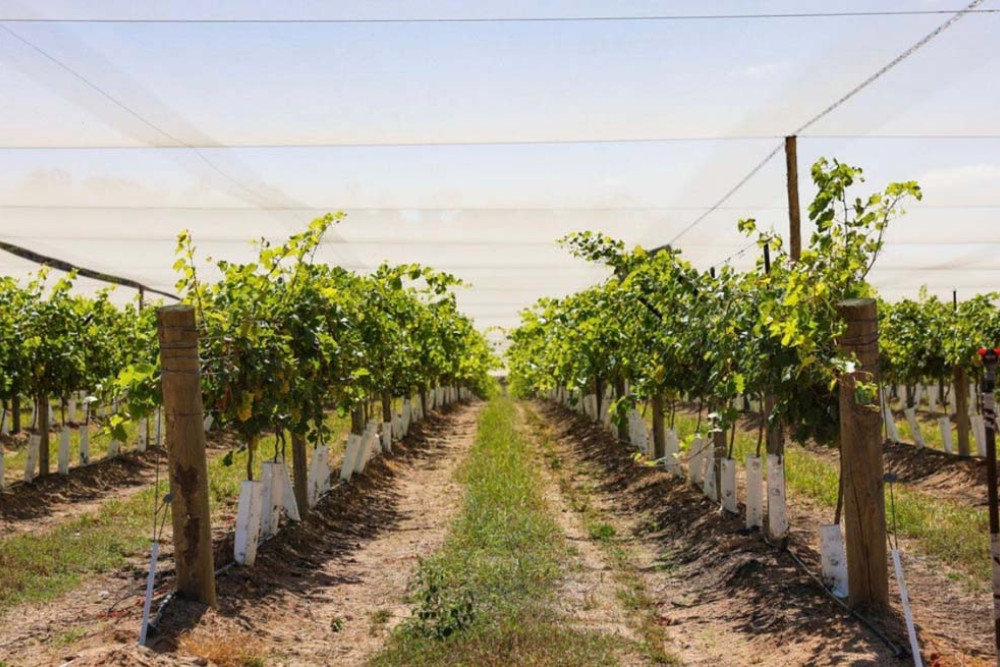On The Land
18 October, 2024
Local vineyard pioneering
TABLE grapes are fast becoming part of the local horticultural industry, with successful operations in Dimbulah, Mutchilba and Mareeba.

Officially established in 2019, Fairview Orchids, located at Dimbulah, is the only locally owned and operated farm of its kind in the region.
The 300-acre vineyard, which currently has 100 acres of table grape vine planted comprising several different varieties, is run by a young, local family and managed by a South African couple with decades of experience in the industry.
One of the farm’s main aims is to help fill a supply shortfall of Australian-grown table grapes during the winter months.
Woolworths and Coles fresh fruit charts show that from around July to October, almost 100% of table grapes are imported, mainly from the United States.
“We’re trying to cut out imported fruit from America, and Australia obviously wants to buy domestic fruit, so with the bigger we get and the more grapes we can grow, we can contribute to that happening,” operations manager Dean Soley said.
“We’re committed to reducing the need for that imported fruit by producing high-quality, locally grown table grapes.”
According to the Australian Table Grape Association, 70% of Australia’s table grapes come from Victoria while Queensland produces 8%, with the Mareeba area being the only supplier in Far North Queensland.
Also, the Mareeba Chamber of Commerce recently released a Tablelands Horticulture Profile for 2024 with preliminary data that showed table grapes contributed $68 million towards the total Gross Value Production in the area.
Fairview Orchards currently has a third of the farm’s capacity planted, boasting over 60,000 vines and, in the coming years, plans to have the entire property become a vineyard.
“Our goals for the future are focused on growth, sustainability and innovation. We aim to expand our vineyard and increase production, while continuing to refine our farming practices to adapt to the challenges of Far North Queensland’s climate,” Dean said.
“Over the next few years, we’ll look at expanding in stages as we work out what the better varieties are moving forwards.”
The picking season for the local farm kicks off in early August and runs until the end of September, spanning just eight weeks, with the rest of year consisting of regular upkeep and pruning of the vines.
“We harvest by hand, and there’s a lot of labour involved in growing grapes. From planting, picking, pruning or putting covers over crops to protect from sunburn, it’s all done by hand,” Dean said.
“For us up here in Far North Queensland, we prune our vine twice a year whereas other growers down south and around the world only have to prune once a year.
“The vines go into dormancy in the cool temperatures, but up here they grow year-round consistently.”
Following the harvest, the fruit from the orchard circulate through a couple of local supermarkets and also makes its way down to the major cities.
“Locally, we sell them to Atherton IGA and this year we’ve began dispersing some of our grapes into Woolworths, that’s for our first-grade fruit.
“Our second-grade fruit usually goes into the Brisbane, Sydney and Melbourne markets.”
The planting process involves acquiring grafted vines from a nursery that are planted in the ground every few metres. The vine then climbs a piece of string or twine where it will spread over 10 separate wires supported by V-shaped steel trellis.
“There would be 100s of kilometres of wire over the whole farm,” Dean said.
Following this, it takes approximately 14 months until the vine yields any fruit.
“Year one is a pretty low yield, year two and three it increases and then you start to get a consistent yield from year three onwards,” Dean said.
“We’re yet to know how long we can out of a vine up here, we’re six years in and are expecting about 10-15 years out of our vines before the yield starts to decline.
“I know that in cooler climates in South Australia, vines can last anywhere between 60-80 years, or more.”
Although a viable, long-term grape farm is yet to be proven in Dimbulah, Dean explained how they are learning on-the-go, including challenges faced in the annual wet season as well as bird damage.
“It’s still trial and error for us but it is very tough growing grapes here. We’re sort of pioneering because not many people up here have done it to this level on this scale,” he said.
“One of the challenges we face is the impact of the wet season. Heavy rains and prolonged periods of high humidity make it extremely difficult to manage disease in the crop, particularly fungal diseases like powdery and downy mildew.
“To tackle that, we’ve had to implement strict disease management protocols including regular monitoring and preventative spraying. However, the timing of treatments is tricky because rain can wash away fungicides, making it less effective.
“We’ve also installed improved drainage systems to help keep the soil drier and reduce the risk of root rot.
“Another challenge we face is bird damage, which can significantly impact our crop yield.
“To address that, we’ve installed permanent bird netting to protect our grapes and reduce losses. This has helped safeguard the vines and maintain the quality of our fruit.
“Although, managing wildlife remains an ongoing effort,” Dean added.


